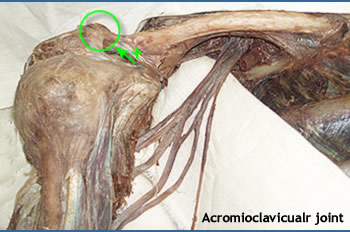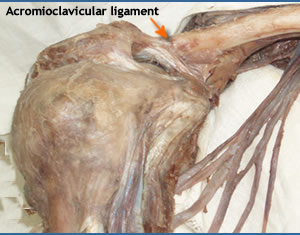| The Acromioclavicular Joint |
| |
|
| Classification |
|
 |
 The acromioclavicular joint is a synovial joint of the plane or gliding type . The acromioclavicular joint is a synovial joint of the plane or gliding type . |
|
| Articulating Surfaces |
|
 |
 Both of the articular surfaces involved are flat and oval. Both of the articular surfaces involved are flat and oval.
The facet on the acromial end of the clavicle faces downwards and laterally
The facet on the medial edge of the acromion faces upwards and medially
|
| |
| Capsule |
|
|
 The fibrous capsule unites the articular margins. It is thickened above to form the acromioclavicular ligament, which resists the tendency for the clavicle to glide laterally. The fibrous capsule unites the articular margins. It is thickened above to form the acromioclavicular ligament, which resists the tendency for the clavicle to glide laterally.  An intra-articular disc is usually present. An intra-articular disc is usually present. |
|
| Synovial membrane |
|
 Lines the capsule and both sides of the disc. Lines the capsule and both sides of the disc. |
|
| Relations |
|
|
| Superior |
|
 The joint is subcutaneous above. Fibres of the deltoid and of trapezius are attached to the capsule. The deltoid extends on to the anterior surface and trapezius on to the posterior surface. The joint is subcutaneous above. Fibres of the deltoid and of trapezius are attached to the capsule. The deltoid extends on to the anterior surface and trapezius on to the posterior surface.
|
| Anterior |
|
 The coraco-acromial ligament is attached just in front of the scapula. The coraco-acromial ligament is attached just in front of the scapula.
|
| Inferior |
|
 The subacromial busa separates it from supraspinatus. The subacromial busa separates it from supraspinatus.
|
|
| Blood-supply And Innervation |
Blood Supply  Derived from branches of the suprascapular and thoraco-acromial arteries. Derived from branches of the suprascapular and thoraco-acromial arteries.
Innervation  suprascapular nerve suprascapular nerve |
|
| Movements |
|
Forward and backward gliding movements can occur and the scapula can rotate in its own plane.
These movements are important as part of the total mechanism of the pectoral girdle, when the scapula swings on the coracoclavicular ligament and the clavicle moves at the sternoclavicualr joint. |
|


